What do you use your attic for? All homeowners have a different idea of what their attic is and how it is best used for their needs. Presuming you know what you want your attic to be, the next question is how do I get up there safely? This post is designed to make sure you’re as informed as possible when making that decision.
We will discuss the following topics;
Current opening assessment
Depending on the age of your house you’ll more than likely have one of two opening types. The most common kind you’ll find in houses built before 2018, a simple piece of MDF or plywood that sits into a lip; usually some architrave left overhanging the opening.
The second type is found in modern builds and is usually designed around the high levels of insulation required by new builds. The main difference with this design is that the hatch usually has a high plywood sides to hold the insulation back as can be seen in diagram 1.
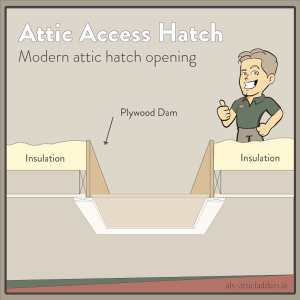
In addition the door includes a considerable amount of insulation and is sealed with a whether strip of some sort.
If you have the first type of opening you have a lot of option, and you need not read the rest of this section. The second type unfortunately leaves no practical options of using this opening for an attic ladder or attic stairs, as the opening would need expensive alterations before the fitting process could begin. However there is an alternative way of achieving the goal ‘safe attic access’. A second access point in the form of a combined attic door and ladder, skip to ‘relocating attic access’ to see more information on this and what to consider when choosing the best location.
Opening size needed
Your opening meets the requirements of the first opening type, it is a basic opening. What now? Well you can have your choice of ladder presuming you have enough clearance room in the attic. But let’s first consider the opening itself, is it big enough for your needs? What are the concerns around heat loss and what other factors should I consider? In an attempt to make it a little easier I will break it into sections. If you have a very small opening and are concerned if an attic ladder will fit here is an article covering just that.
Primary considerations
I have decided to order the primary concerns based on the idea that long term factors are more important, and secondary concerns will follow. The primary considerations will focus in the two questions below.
What will I be carrying up?
Determining what you will be caring up to your attic or maybe more importantly what you might be in future is vital to think through at this stage. Considering the things you bring up now before deciding on an opening size is usually as far as most people ever get before making a decision. The fact you’re reading this I’m guessing you’re not most people and you have the luxury of thinking ahead.
Story time: So you have small children and you have moved into your first house, you’re currently using a step ladder (or your partner) to access the attic. You are storing some suitcases, old kids toys, and the Christmas decorations. The time has come to invest in a more convenient way of getting up and down, you call us and you have already decided on going for the most cost effective ladder. We use your existing opening and the jobs done. A few months down the line you have gone on a family holiday and you’re back and unpacked, you then realise the new suitcase you bought for your growing family is too big to fit through the attic opening. This is a version of a story we see all too often.
This may not be your situation, you may even have plenty of other storage but the point remains, make sure to think it through. The standard attic opening in Ireland is 50cm x 50cm, that’s not very useful with growing kids. The wooden ladders we fit have an opening size depending on the distance between your joists of 55cm wide by 115 cm in length or 70cm wide by 120cm in length. This is an opening size that we have found strikes a nice balance of a very usable opening vs the potential heat loss of having an opening, more on the insulation value of attic stairs in the next section.
How often you’ll use it?
Calculating how often you will be up and down the attic steps is definitely worth considering. You reckon you can manage to just squeeze the suitcases up through the attic opening you have, that’s great but how often are they used? For some once a year maybe? But what about if you are you a frequent flyer! I’m just using that as an example but you get the idea. Something may fit up and down with a squeeze but that may not be practical in the long term if it needs to be done regularly.
How do you fit up and down through the opening? Fitting a ladder to an existing opening definitely makes it easier to get up and down but the question it does it make it easy? the size of your opening will determine this. You may still be a tight fit, with the average attic opening 55cm. Again time to consider how often it will be used, if it is four or five times a year I wouldn’t worry at all. However more than this I would lean towards a larger opening.
Choosing the size of the opening you want/need is better done when factoring in the above, if you’re not sure you can always give us a call and we can guide you.
Secondary considerations
Again these consideration were ordered with the view of giving the long term affects more importance. I appreciate cost may be a primary consideration in a lot of instances.
How much heat loss
U-Value is the calculation of thermal transmittance through a material of combination of materials. It is how much heat can pass through the material rather than how much the material can resists the transmission. Therefore the higher the U-Value number the more heat is lost (ie the lower the U-Value the better).
If you have a standard attic opening door usually a piece of MDF you have an opening with the U-Value of around 2.56 W/m² K. Our Folding Attic Stairs is on of the best combinations of cost vs Insulation and has a U-Value of 1.3 W/m² K. The Gold Star Attic Door and Ladder is our premium ladders and has an amazing U-value of 0.49 W/m² K.
| Standard Trapdoor | Folding Attic Stairs | The Gold Star | |
| U-Value | 2.56 W/m² K | 1.3 W/m² K | 0.49 W/m² K |
| Cost | €350 *Cost of fitting ladder in existing opening | €580 | €700 |
U-Value vs Cost of Attic Ladders Fitted
Cost of opening size
If you are undecided between leaving your opening size as is or going for the larger opening after considering the above sections, let’s look at the actual cost. To leave your opening as is you will be accepting the 2.56 W/m² K U-Value, this is a cost that will add up over time but not necessarily not what we will look at here.
We are going to look at the immediate cost. So obviously there is the difference in cost of €230 from The Glide Away + to the Folding Attic Stairs but what is the actual amount we charge for cutting the opening? The answer; nothing. The proof, we charge the same for replacing a wooden ladder as fitting one after enlarging the opening. The difference in price between The Glide Away + installed into your existing opening and the Folding Attic Stairs is purely the production cost of the ladders.
With this in mind let’s draw a line through this section and come to the conclusion that if you’re still on the fence about the opening size it’s just down to preference.
Relocating Attic Access
Choosing the best location
Under the assumption that you will be relocating your attic access for the purpose of enlarging your opening while installing an attic stairs, what are the main considerations?
Let’s have a quick look at choosing a preferred room, hopefully there is an obvious room in mind like a home office, walk-in wardrobe or large storage room that would be perfect. In most cases you’re looking at putting the opening in either the main bedroom or maybe one of your kids rooms, so it’s important to again think through how and when the opening will be used. For example having it in the kids room won’t be ideal on Christmas eve. So run through a mental list of possible uses and issues.
Setting aside personal preference, we can focus on practical considerations.
*None of the following is required to be done by you if you book one of our fitters, it is a guide for those who want to be sure before we arrive or a helpful guide to those who are not in our fitting areas.
First thing to note is the length of your opening will follow the direction of your ceiling joists; as illustrated in diagram 2 . With that in mind next note is that the opening will be a maximum of 120cm long. In addition to the 120cm the attic stairs will need 30 centimetres from the start of the opening to operate, this is what is needed for the ladder to open into position. Next to keep in mind; the 30cm clearance doesn’t account for you. The 30cm is a minimum, this should be reserved for tight spaces, to get a comfortable fit consider adding enough space for you with your hands full. Now add the 120cm length, the 30cm clearance and whatever you think you will need for you. You have a rough overall measurement to test possible locations.
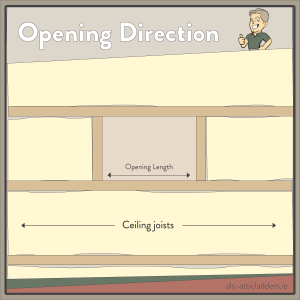
- Opening will follow the direction of the ceiling joists.
- The largest opening length will be 120cm in length.
- 30cm clearance from the opening needed for operation (minimum).
- Factor in enough space for you.
- Add the opening length, min clearance and space for you and you have your testing measurement
If you currently have access to your attic now is the time to stick your head up and scan the attic for possible opening obstructions, for example water tanks, pipes and cables. It can be tricky to calculate where everything is in relation to your rooms, but you’re just trying to get a sense of what’s possible so it’s just a rough estimate. You can rule out any previous choices based on these obstructions.
Choosing the right attic ladder stairs
If you haven’t read the two sections ‘Current opening assessment’ and ‘Opening size needed’ go back and see if the factors discussed determine if you need an aluminium or a wooden attic stairs. If you still have the option of the two types let’s get into the considerations.
Interested in how the different types of attic ladders work? see our post on the topic.
Primary considerations
Just as above in the opening size section I will order the considerations on the basis that long term factors are more important than immediate cost.
What will I be carrying up and down?
Illustrated in the opening size section a large part of choosing the right attic ladder for you can be down to determining what you carry and what you may end carrying up and down from your attic.
Weight Capacity – Will the ladder you are considering hold the weight of you and the heaviest items you will be carrying up? This is usually not too difficult to work out, any good attic ladder stairs will have a max load capacity – Usually 150kg (23.6 st.) as with all of our standard ladders. The frequency of use also crosses over with the weight capacity, a wooden attic stairs will outperform a standard aluminium ladder over time under load, but more on that in the next section.
Attic ladder steps – The steps of an attic ladder may not jump to mind when you’re choosing an attic ladder stairs, however they come in many shapes and sizes, and really do effect the safety and ease of use of the ladder.
My recommendations for a metal ladder are to go with a flat step over a rounded step. Choose a ladder which has protruding grip rather than recessed grip on the step. The deeper the step the better, a lot of the cheaper ladders have a really thin step, which really doesn’t inspire confidence when ascending while holding a box.
For a wooden attic stairs the steps are usually much less of an issue when deciding on a ladder. This is due to the fact that the steps are around twice the depth of a metal ladder. Just keep in mind the deeper the step is usually the more stability you will have.
Handrail – A handrail is preferential when choosing an attic ladder, it really ads to safety especially when a ladder is installed beside a staircase. Believe it or not, not all handrails are made equal. Some are thin and flex under load and some are wide and sturdy. Take The Glide Away+ it comes with a handrail that far exceeds the standard of aluminium ladder handrails.
Other handrails come with a plastic grip or a soft grip. Even a simple feature like the colour can add to the safety, take our Folding Attic Stairs, it is installed with a red handrail. The red can be a life saver in the extreme event of you falling, the colour could just make the difference and catch your peripheral vision. Not something that you should choose a ladder based on, but good to keep in mind when two similar options are being compared.
How often will you use it?
Do you actually need an attic ladder? If you are accessing the attic more than once a year I think the added safety alone is worth the investment. Step ladders can be dangerous when used incorrectly, given people usually have a general use step ladder; which are not very tall. Guidelines of most types of stepladders state that the top two steps are not to be used, this means if you are using a step ladder you’re probably going to be needing the top steps to access the attic. Of course I advise agains this and have known people to really injure themselves attempting to access their attic this way.
Aluminium vs. Wooden – Sometimes it’s just down to personal preference, the wooden ladders look more like a nice piece of furniture than an industrial looking metal ladder. But there can be more to the choice than that, cost being the most obvious. However we are going to look at the difference in the two from a frequency of use perspective.
Briefly outlined above the weight capacity combined with the frequency of use can be a determining factor of choosing between Aluminium or Wooden attic ladder. The Aluminium ladder is a tough and resilient ladder but when used with weight the wooden ladder will better stand up to this sort of use. This is because of design of sliding aluminium ladders, they built light and compact and the moving parts are kept to minimum dimensions. The sliding mechanisms are effective, but compared to the bulkier wooden ladders folding joints, they fatigue far quicker. If you’re looking for a work horse, the wooden ladders are your best option.
Spring assisted – Having a spring assisted ladder is of huge importance if you have any joint or muscle problems or any strength issues at all. This is more related to the wooden attic ladders as the standard aluminium ladders are light and take little effort to extend. I advise asking your ladder installer when booking if a ladder is easy to extend and if it is spring assisted, both of our current most popular wooden ladders have a strong spring to allow for easy use.
Secondary considerations
How much heat you may loose
If you go with an aluminium ladder and use your current opening you will have the U-Value of around 2.56 W/m² K if your hatch is standard, as defined in the first section. The alternatives we offer range from a good U-Value of 1.3 W/m² K for the Folding Attic Stairs to an exceptional U-Value of .49 W/m² K with the ‘Gold Star’.
Cost of getting an attic ladder installed
The cost of getting an attic ladder installed can vary quite a lot, like with any service, price can be dictated by many factors. The quality of the ladder is a factor, the quality of the service another. Our calculation always starts with the ladder, we find the best quality ladder that we can, at the lowest possible price. We work out the additional operational costs along with a fitting price after. This enables us to operate at the minimum cost to you, with maximum customer satisfaction. For this reason we can offer The Glide Away + at a really competitive cost of €350. The same goes for the Folding Attic Stairs at €580 and the premium Gold Star installed for €700.
Types of attic ladders available
Let’s have a look at the different types attic ladder and the advantages and disadvantages.
Folding Attic Stairs
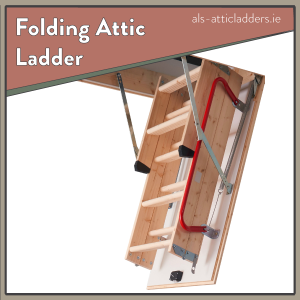
The folding attic stars is one of the most popular attic ladder designs and with good reason, it not only functions great but it fits in most attic spaces. Thanks to the compact design the in-attic dimensions are at its highest point just 45cm from the ceiling.
The design also allows no need for in-attic clearance around the opening. This type of ladder is constructed to be one piece, both door and ladder. This gives the advantage of being able to provide perfect operation, along with precise insulation properties from the factory.
Sliding Attic Ladder
The sliding attic ladder design is another very popular choice, the sliding sections allow for effortless lowering and is a cost effective option. The design also allows it to fit into small openings (a minimum of just 51cm by 43cm for some models).
The drawback with this design is it needs a good amount of in-attic clearance and is not alway able to fit in smaller sized attics. An example of this is The Glide Away + it require a clearance of 71cm beyond the opening, and an operational height of 71cm.
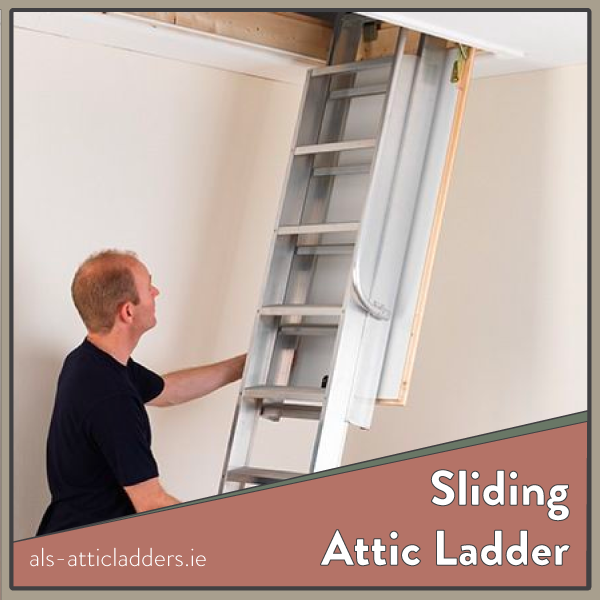
Concertina
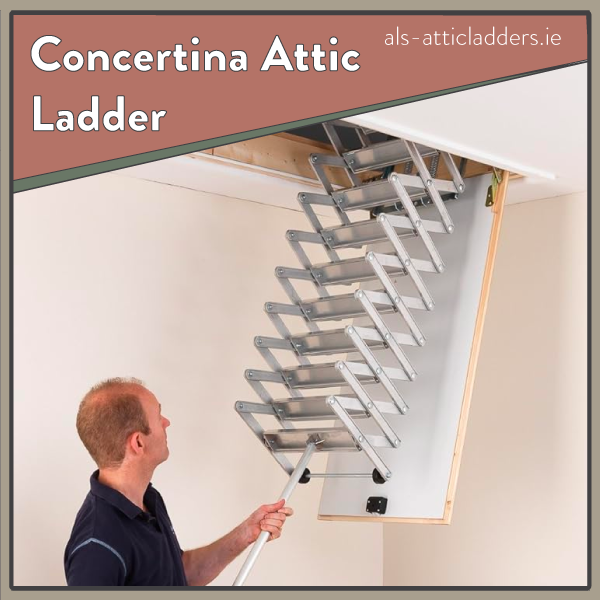
The concertina attic ladder is not as popular as the former two ladder designs, but they have their purpose. They are perfect for when you have both a small hatch and tight space in the attic. The ladder extends and contracts like an accordion and is very compact before being stowed away in the attic.
The reason for them not being as popular as the other two designs is that the price is not much different than a wooden attic ladder and door, which has the same in-attic compactness but also extends the opening. This is what I would refer to as a specialty ladder, it is perfect for a very specific instance.
Telescopic Attic Ladder
Another specialty attic ladder, and one that seems to be growing in popularity, the telescopic design. This is most lightly due to it addressing most of the general issues of fitting an attic ladder in a small opening with a small amount of attic clearance space. This design of ladder can be fitted with an opening of just 60cm x 50cm and only requires a vertical and horizontal clearance of 24cm.
There is a downside to this ladder type and that is cost, models can be three times more expensive compared to the sliding attic ladder. However when an attic ladder is needed the extra cost can be justified over the cost of creating a new opening.

Weight Capacity
When it comes to considering the weight capacity of an attic ladder, it is pretty straight forward. Most types of attic ladders are usually rated up to 150 kg (23.6 st.), with the exception of the concertina style attic ladder some models of this ladder can have limits of 100 kg (15.7 st.). Be mindful that some ladders may note a ‘tested to’ weight, this number in truth is irrelevant. For most you will never come close to reaching these maximum weights.
Attic Ladder Steps
As covered in the previous section the steps of an attic ladder can come in many shapes and sizes, and really do effect the safety and ease of use of the ladder. Comparing the types of steps of different types of attic ladders is straight forward. The main considerations are the shape of the step, the grip it provides and depth of the step.
Wooden – All of the folding attic stairs ‘wooden ladders’ have similar steps, flat with varying designs of grove patterns. The advantage of this design is that it usually provides a confident assent thanks to a flat, deep step. The grip is less important on this ladder due to this depth, but compared to some aluminium ladders the step provides less grip.
Metal – The varying styles of aluminium ladders usually provide a strong grip over time. The steps however vary a lot in depth and shape. In my opinion the step shape to avoid is the rounded type, they offer grip but they don’t provide confidence and can put unnecessary pressure on the centre of your foot, especially when you are carrying weight. The majority of aluminium and steel attic ladders have a flat step, although the level of grip can vary.
You will see that some of the more expensive models of sliding attic ladders offer the deepest step available.
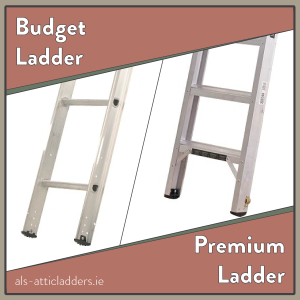
Handrails
The handrail section above covers the different characteristics of attic ladder handrails, here we will be looking at handrails as they relate to the different types of ladders.
Most but not all models of the folding attic stairs include a handrail as standard, and most option have a similar style, so not much of an issue if you’re looking at this ladder type.
The sliding attic ladders have many different options available, most notably the option of two handrails, or a handrail that extends into the attic to provide assistance when getting off the ladder.
Due to how the concertina ladder operates it is not common for this style to provide the option of a handrail, and is a big disadvantage of the ladder. Some concertina ladders are constructed with rounded parts to allow for more comfortable use, but this doesn’t provide the same ease and comfort of a dedicated handrail.
The telescopic ladders also cannot offer the option of a handrail, however the construction of the ladder does provide the ability to quite comfortably hold the ladder itself for support.
Spring assisted
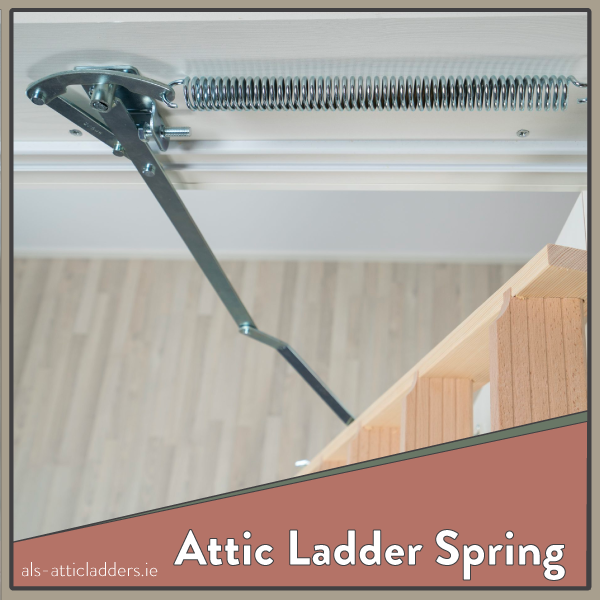
Having a ladder that is spring assisted is not always a luxury for some it is a necessity, for anyone without the strength or balance to use a standard attic ladder, spring assisted models are essential. While not all spring assisted ladders work the same they all use the same principle, the spring reduces the effort on the part of the user.
The spring assistance can be depending on the model designed to take the weight off of the ladder and door or either one independently. All of our wooden ladders are spring assisted and The Heavy Duty aluminium attic ladder is also a spring assisted option.
Insulation Properties
With the increasing cost of energy prices insulation can be a big factor when choosing your attic ladder or attic stairs. If your current trapdoor isn’t insulated, the best type of ladder is the folding attic stairs. The ladder is constructed to be one piece enabling manufacturers to achieve very low U-values.
The most insulated model on the market offers a U-value of just 0.49 W/m² K. If you are choosing any of the other styles of ladders there is the option of adding an insulated plastic trapdoor at an additional price, not all openings are suitable for these doors. You can also insulated your current trapdoor.
If you want an insulated opening without having a wooden ladder fitted see the options we offer to insulate any attic opening.

How we choose the ladders we Install
When choosing the attic ladders we fit, all of the above is considered from the perspective of you the homeowner. We calculate the balance between the price to you, the safety provided and how reliable it will be over time. I believe our current line up of services offer the best balance of the above. Our booking form has been created to offer a quick and easy booking process, made to fit around your busy lifestyle. If you are unsure about the attic ladder best suited to you, we are always here to guide you in the right direction.
4 Responses